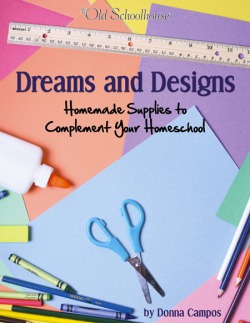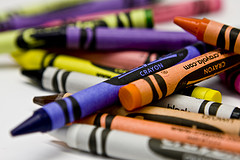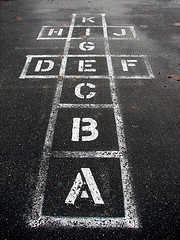Dreams and Designs:
Homemade Supplies to Complement Your Homeschool
When my children were very young, we had very little extra money in our budget. We stayed home a lot, kept things simple, enjoyed friendships with other families and our church members, rarely traveled, and just enjoyed bonding as a family. We began homeschooling when our oldest was four. Technically, we began homeschooling the day she was born, but that just shows our view of what homeschooling really is…a lifelong love of learning and discipleship with your children!
I wanted to do preschool types of things with my children, but didn’t have much money. My mom suggested some ideas we could do at home together, and I also gleaned ideas from my friends. I bought a couple of books that had a lot of ideas, and we did some things from that. Several times, I asked my girls’ Sunday School teachers how the girls were doing. They were surprised to learn that our girls weren’t attending a local preschool, because they were social, obedient (for the most part!), had preschool skills, etc.
I firmly believe that if a parent is able to stay at home with their children, attending preschool is not a necessary part of childhood. Learning a lot of preschool-types of skills IS necessary, but they are so easily taught by Mom or Dad. I only knew one other gal who had children my daughter’s age – when they were babies – so she and I began meeting together once a week for a playdate. Not only did I enjoy the time to visit with another mom who shared similar beliefs and values as me, our daughters grew up together and learned so much from each other. As time went on, we made friends with other families who had young children, and our circle of friendships grew.
I wanted to do preschool types of things with my children, but didn’t have much money. My mom suggested some ideas we could do at home together, and I also gleaned ideas from my friends. I bought a couple of books that had a lot of ideas, and we did some things from that. Several times, I asked my girls’ Sunday School teachers how the girls were doing. They were surprised to learn that our girls weren’t attending a local preschool, because they were social, obedient (for the most part!), had preschool skills, etc.
I firmly believe that if a parent is able to stay at home with their children, attending preschool is not a necessary part of childhood. Learning a lot of preschool-types of skills IS necessary, but they are so easily taught by Mom or Dad. I only knew one other gal who had children my daughter’s age – when they were babies – so she and I began meeting together once a week for a playdate. Not only did I enjoy the time to visit with another mom who shared similar beliefs and values as me, our daughters grew up together and learned so much from each other. As time went on, we made friends with other families who had young children, and our circle of friendships grew.
Because I have always loved learning, I wanted my children to love learning, too. I made it a big priority in our family to have plenty of story times, arts and crafts, practice with letters and numbers, colors, days of the week, and so many fun little skills like that in our daily life. But it was still very casual and lots of fun and games – plus, I spent very little during the day doing this with the girls. No need for 2-4 hours per day, that’s for sure!
What happened because of all of this? Well, when our oldest had reached the age to attend kindergarten in our state (she was 5-3/4 by the day school started), we realized that even with working casually with her over the last couple of years, she was advanced in her skills, and would have been bored to tears in kindergarten. This led to our journey in homeschooling, and it has been such a blessed adventure.
While many families think to themselves, "Wow – my child is far advanced beyond her peers – she is going to be at the top of her class!" when their children start kindergarten, I think this attitude is actually harmful to our children. Why be prideful about our children, and then use that pride to actually harm our children by not allowing them to flourish and grow academically at their own pace and in so many other ways?
Our attitude instead was, "Wow – my child is advanced beyond her peers – what can we do to teach and nurture her at her level now, so she won’t be held back academically and emotionally?" After years of teaching in the public school system and working with children voluntarily, I can’t imagine placing an advanced child into a kindergarten program where 95% of the classmates don’t know their seasons, days of the week, letters, numbers, colors, etc. And lest you think that things improve all that much in the first grade, you would probably be dismayed to learn that almost all first grades spend 26 weeks of the school year (out of 36) learning the letters of the alphabet and all of the other things I’ve already mentioned. (The reading/spelling curriculum we use taught all 26 letters in 5-7 days, easy. Why drag this out over six months, unless a child has learning disabilities? I just don’t get it.)
Now, I know that the masses need to be educated, but why should we hold children back who are reading and understanding at a higher level? And for the average boy? Why, quite a few of them would often be better off not even starting school until they are around 7, unless they are the type who really loves to sit still and learn! Public school organization is so feminized, anyway – why should boys be spending most of their young lives sitting squarely in a desk, doing pencil and paper work, and cutting with scissors? Let them be boys and learn in a mode that meets their needs, without all the sitting time when they are younger…
Okay, I’ll get off of my soapbox.
What happened because of all of this? Well, when our oldest had reached the age to attend kindergarten in our state (she was 5-3/4 by the day school started), we realized that even with working casually with her over the last couple of years, she was advanced in her skills, and would have been bored to tears in kindergarten. This led to our journey in homeschooling, and it has been such a blessed adventure.
While many families think to themselves, "Wow – my child is far advanced beyond her peers – she is going to be at the top of her class!" when their children start kindergarten, I think this attitude is actually harmful to our children. Why be prideful about our children, and then use that pride to actually harm our children by not allowing them to flourish and grow academically at their own pace and in so many other ways?
Our attitude instead was, "Wow – my child is advanced beyond her peers – what can we do to teach and nurture her at her level now, so she won’t be held back academically and emotionally?" After years of teaching in the public school system and working with children voluntarily, I can’t imagine placing an advanced child into a kindergarten program where 95% of the classmates don’t know their seasons, days of the week, letters, numbers, colors, etc. And lest you think that things improve all that much in the first grade, you would probably be dismayed to learn that almost all first grades spend 26 weeks of the school year (out of 36) learning the letters of the alphabet and all of the other things I’ve already mentioned. (The reading/spelling curriculum we use taught all 26 letters in 5-7 days, easy. Why drag this out over six months, unless a child has learning disabilities? I just don’t get it.)
Now, I know that the masses need to be educated, but why should we hold children back who are reading and understanding at a higher level? And for the average boy? Why, quite a few of them would often be better off not even starting school until they are around 7, unless they are the type who really loves to sit still and learn! Public school organization is so feminized, anyway – why should boys be spending most of their young lives sitting squarely in a desk, doing pencil and paper work, and cutting with scissors? Let them be boys and learn in a mode that meets their needs, without all the sitting time when they are younger…
Okay, I’ll get off of my soapbox.
Today, I just finished reading a new e-book called, Dreams and Designs—Homemade Supplies to Complement Your Homeschool that is offered in the The Schoolhouse Store, part of The Old Schoolhouse magazine. Even though I haven’t used preschool activities for a lot of years now, it was so much fun to read through this 54-page ebook!
I would have really enjoyed using Dreams and Designs—Homemade Supplies to Complement Your Homeschool in our preschool and early elementary years. Donna Campos, the author of this e-book, offers so many creative ideas of activity centers, learning stations, preschool activities, and skill development. What impressed me the most is that she provides very cheap and inexpensive methods and ways of doing this in your own home.
I used to receive those colorful, flashy catalogs in the mail when the girls were younger. After all, I was still on a lot of "teacher" mailing lists, right? I would see so many things that looked so wonderful to have in our home, but the price tag kept me from ordering much at all. If I had a copy of Dreams and Designs—Homemade Supplies to Complement Your Homeschool, I would have thrown out the catalogs and just enjoyed using the ideas in this e-book instead!
I would have really enjoyed using Dreams and Designs—Homemade Supplies to Complement Your Homeschool in our preschool and early elementary years. Donna Campos, the author of this e-book, offers so many creative ideas of activity centers, learning stations, preschool activities, and skill development. What impressed me the most is that she provides very cheap and inexpensive methods and ways of doing this in your own home.
I used to receive those colorful, flashy catalogs in the mail when the girls were younger. After all, I was still on a lot of "teacher" mailing lists, right? I would see so many things that looked so wonderful to have in our home, but the price tag kept me from ordering much at all. If I had a copy of Dreams and Designs—Homemade Supplies to Complement Your Homeschool, I would have thrown out the catalogs and just enjoyed using the ideas in this e-book instead!
Donna teaches us how to make and use calendars that are large and hands-on, how to design puppet theaters and scrolling stories, and how to design personal partitions that give children their own little space to work on school projects or activities. She also provides many ideas of how to design activity stations and centers, something that started to become very popular in the public schools in the 1990s, but hardly anyone had the extra time or money to use them in their classrooms.
Donna also provides us with photos and directions on how to design different types of storage containers and rolling carts, plus a lot more, with household items. For those who like having everything "in place" in their homes, this would be a dream come true!
Just when you think this e-book couldn’t provide any more for your family and learning, she also discusses many ways to use file folders to enhance learning. I was impressed with the detailed directions to make file folder timelines for history studies.
She also includes a section on some great ways to use cheap and inexpensive index cards for lots of learning activities, including for those children who have learning challenges or are on the autism spectrum.
I really appreciate Donna Campos’ heart for the family and how to educate children frugally as well as having a lot of fun with them.
The next time you are tempted to plop your children into public school, or keep them at home with a boring stack of workbooks, consider bringing this e-book into your home for $12.45: Dreams and Designs—Homemade Supplies to Complement Your Homeschool
I don’t think you’ll be disappointed!
Copyright © 2009 by Julieanne Miller
Donna also provides us with photos and directions on how to design different types of storage containers and rolling carts, plus a lot more, with household items. For those who like having everything "in place" in their homes, this would be a dream come true!
Just when you think this e-book couldn’t provide any more for your family and learning, she also discusses many ways to use file folders to enhance learning. I was impressed with the detailed directions to make file folder timelines for history studies.
She also includes a section on some great ways to use cheap and inexpensive index cards for lots of learning activities, including for those children who have learning challenges or are on the autism spectrum.
I really appreciate Donna Campos’ heart for the family and how to educate children frugally as well as having a lot of fun with them.
The next time you are tempted to plop your children into public school, or keep them at home with a boring stack of workbooks, consider bringing this e-book into your home for $12.45: Dreams and Designs—Homemade Supplies to Complement Your Homeschool
I don’t think you’ll be disappointed!
Copyright © 2009 by Julieanne Miller




